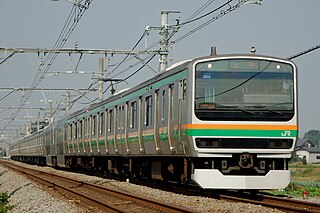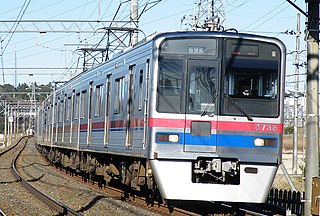
Taitō is a special ward located in Tokyo Metropolis, Japan. In English, it is known as Taitō City.

Ueno Station is a major railway station in Tokyo's Taitō ward. It is the station used to reach the Ueno district and Ueno Park—which contains Tokyo National Museum, The National Museum of Western Art, Ueno Zoo, Tokyo University of the Arts and other famous cultural facilities. A major commuter hub, it is also the traditional terminus for long-distance trains from northern Japan, although with the extension of the Shinkansen lines to Tokyo Station this role has diminished in recent years. A similar extension of conventional lines extended the Takasaki Line, Utsunomiya Line and Joban Line to Tokyo Station via the Ueno-Tokyo Line in March 2015, using existing little-used tracks and a new viaduct.

Ueno Park is a spacious public park in the Ueno district of Taitō, Tokyo, Japan. The park was established in 1873 on lands formerly belonging to the temple of Kan'ei-ji. Amongst the country's first public parks, it was founded following the western example as part of the borrowing and assimilation of international practices that characterizes the early Meiji period. The home of a number of major museums, Ueno Park is also celebrated in spring for its cherry blossoms and hanami. In recent times the park and its attractions have drawn over ten million visitors a year, making it Japan's most popular city park.

Hachikō was a Japanese Akita dog remembered for his remarkable loyalty to his owner, Hidesaburō Ueno, for whom he continued to wait for over nine years following Ueno's death.

Ueno is a village located in Gunma Prefecture, Japan. As of February 2015, the village had an estimated population of 1,265, and a population density of 6.96 persons per km². Its total area is 181.85 km². The village has the lowest population density of any municipality in Japan.

The Ueno Zoo Monorail Line is a 0.3 km long suspended railway operated by the Tokyo Metropolitan Bureau of Transportation (Toei). It lies within the Ueno Zoo in Taitō, Tokyo, Japan. The monorail is similar to the Schwebebahn Wuppertal, but has rubber tires rather than steel wheels. Many of the parts manufactured for the monorail were off-the-shelf. The first monorail in the nation, it has two stations, single track, and operates at 600 V DC. The line began operating on December 17, 1957, and except for a suspension during 2001–2002, has been in operation since. Being located inside the zoo, it only operates on days when the zoo is open, and between 9:40 a.m. and 4:30 p.m.; departures are scheduled every seven minutes. The fare for the 90-second trip is 150 yen.

The Takasaki Line is a Japanese railway line which connects Ōmiya Station in Saitama, Saitama Prefecture and Takasaki Station in Takasaki, Gunma Prefecture. It is owned and operated by the East Japan Railway Company. The Ueno - Omiya - Takasaki - Shinmaebashi line was the first privately built railway in Japan.

The Keisei Main Line is a railway line of Japanese private railway company Keisei Electric Railway connecting Tokyo and Narita, Japan. It is the main line of Keisei's railway network. Built as an interurban between Tokyo and Narita in early 20th century, the line has served as a main access route to Narita International Airport since 1978. It also serves major cities along the line such as Funabashi, Narashino, and Sakura.

Ueno Hikoma was a pioneer Japanese photographer, born in Nagasaki. He is noted for his fine portraits, often of important Japanese and foreign figures, and for his excellent landscapes, particularly of Nagasaki and its surroundings. Ueno was a major figure in nineteenth-century Japanese photography as a commercially and artistically successful photographer and as an instructor.

Keisei Ueno Station is a railway station in Taitō, Tokyo, Japan, operated by the private railway operator Keisei Electric Railway. It is the terminus of the Keisei Main Line and is a short distance from JR Ueno Station.

The Ueno–Tokyo Line, formerly known as the Tōhoku Through Line, is a railway line in Tokyo, Japan, operated by the railway operator East Japan Railway Company, linking Ueno Station and Tokyo Station, extending the services of the Utsunomiya Line, the Takasaki Line, and the Joban Line southward and onto the Tokaido Main Line and vice versa. The project began on 30 May 2008. The line opened with the 14 March 2015 timetable revision, with the project costing about JPY40 billion.

Nebria livida is a species of ground beetle with two subspecies:
Trephionus is a genus of beetles in the family Carabidae, containing the following species: Five new species were described in 2018 from Japan.

Trechinae is a subfamily in the ground beetle family, Carabidae.
Nebria daisetsuzana is a species of ground beetle in the Nebriinae subfamily that is endemic to Japan.
Nebria pusilla is a species of black coloured ground beetle in the Nebriinae subfamily that is endemic to Japan. The species have 2 subspecies both of which can be found in the same nation; Nebria pusilla pusilla and Nebria pusilla yatsuana.

The Tokiwa (ときわ) is a limited express service operated by East Japan Railway Company between Shinagawa in Tokyo and Iwaki via the Joban Line and Ueno-Tokyo Line since 14 March 2015. The services replaced the former Fresh Hitachi services operated on the Joban Line between Ueno and Iwaki. The Tokiwa train service name was also formerly used for semi-express services operated by Japanese National Railways (JNR) from June 1958 until March 1985.
















